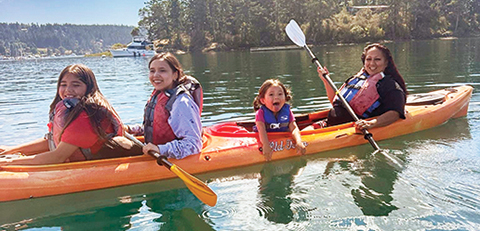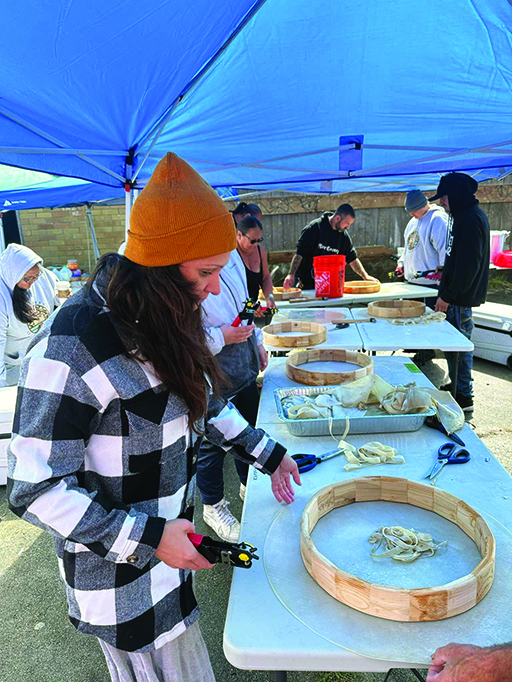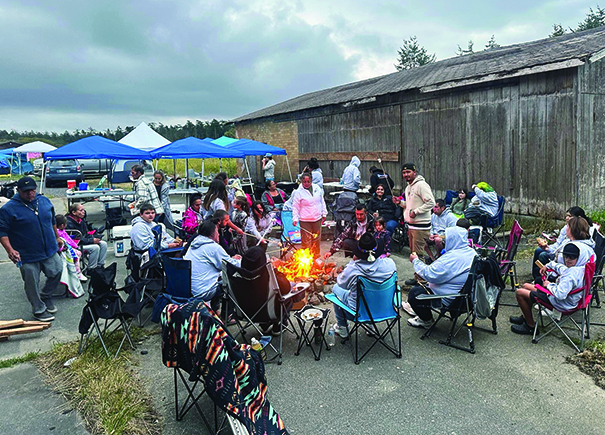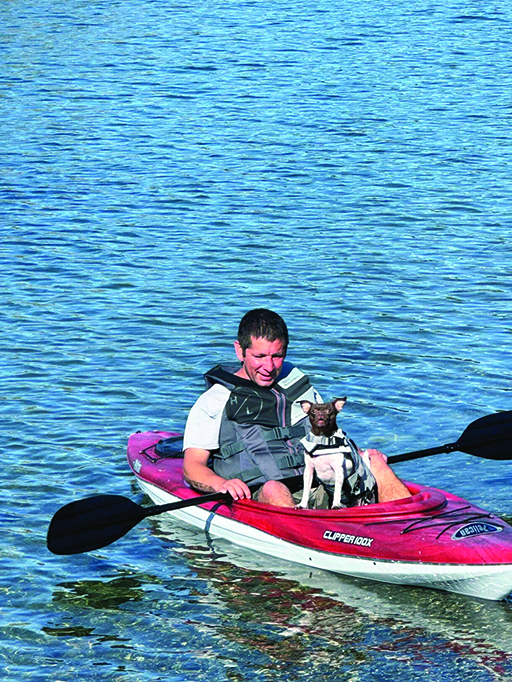
By Kalvin Valdillez, Tulalip News; photos courtesy of Kali Joseph
“Culture is the answer,” expressed Kali Joseph, Tulalip Resource Center’s Program Coordinator. “It’s what we’ve been doing since time immemorial. There are research studies, like the Healing Power of the Canoe, that I learned when I was in grad school. Basically, the study found that those who participated in a certain cultural activity, it was associated with reduced risk of suicide, depression, or substance use disorder. However, our people have known that it’s the answer since time immemorial, before empirical evidence and research studies existed, we’ve known it in our hearts and in our blood. It’s our medicine.”
On the early morning of August 22, dozens of Tulalip tribal and community members met at the Tribal courthouse to embark on adventure across the Salish Sea. Filled with anticipation and excitement, the people piled into a bus headed toward Anacortes to catch the morning ferry to Lopez Island.
For the third consecutive year, the Tulalip Resource Center organized an event that keeps growing in popularity and celebrates the sobriety of the local recovery community. During a weeklong camping trip, at the third largest island of the San Juans, attendees can participate in numerous group activities, while also taking the time to reflect on their healing journey. Together, they continue to build upon that work with others who are also striving to maintain a clean and sober lifestyle. And furthermore, they are provided the space to learn and converse about why and how they acquired an addiction.

Said Kali, “It’s important because they get to be a part of collective healing and work at reversing the harm that was done to us. In substance abuse disorder there’s a lot of theories and philosophies on why it’s a thing. Is it a personal choice or a moral failing? Is it just because drugs exist and they’re tempting? Is it risky behavior? But really, we know as Native people, with all the trauma and adversity faced in our past, it’s a coping mechanism. It’s something that devastates tribal communities at higher rates than non-Native communities. It feels like we’re reversing some of that harm.”
To back up Kali’s statement, let’s take a look at some local statistics. The Snohomish County Opioid Overdose and Prevention Data and Dashboard reports that there were 188 overdose deaths in our county alone last year. And according to the Washington State Department of Health’s Opioid and Drug Use Data Dashboard, there was a state average of about 30 overdose deaths per 100,000 people in 2022 for all other races and ethnicities. And high above those charted stats, the number for Alaskan Natives/American Indians clocks in at a staggering 120 deaths per 100,000 population – that’s a death rate four times higher than non-Native people statewide.
With that shocking disparity, locally and nationally, it’s easy to get bogged down in those statistics and focus on the damage the opioid epidemic is bringing to our tribal nations and families.This can leave many with a feeling of helplessness and despair when thinking about all the lives lost.

But on the flipside, those stats don’t speak on the resiliency of those individuals who are able to break away from the grasp of addiction. Which is no easy feat. But with the right support system, cultural gatherings, and a desire to understand and overcome their addiction, tribal members are taking back control of their lives, one step at a time.
This is why it’s important to celebrate their achievement of getting clean whenever possible. Because in turn, those success stories help raise awareness about substance abuse disorder and inspires others to break out of that cycle.
Over the years, as the opioid epidemic spread, the Tulalip Tribes has worked to create spaces for their membership to start their journey on the road to recovery. This includes the implementation of the Healing to Wellness Court, the establishment of the Healing Lodge, and a concentrated effort by the Tulalip Police Department to get drugs off the rez.
Additionally, the Recovery Resource Center continues to be a safe space for those struggling with addiction. By hosting events such as Narcan distributions and weekly NA meetings, as well as developing a recovery softball team, people are able to make connections with each other and build community while working toward the same goals.

The annual Recovery Campout is the perfect example of how celebrating those in recovery can inspire others to do the same. And it’s easy to see this taking place in real time by looking at the number of participants each year. At the first campout, there were 35 attendees. That doubled the second year as 72 community members took part in the campout. This year, the attendance rate rose again by 13, bringing the total to 85.
But it doesn’t stop there. The news about the Recovery Campout, and all the good work and fun that is had during the event, reached the ears of several tribes throughout the state. Three other tribes joined Tulalip for the third annual trip to Lopez including Nez Pierce, Port Gamble S’Klallam, and Puyallup. The nations of Makah and Quileute recently began hosting Recovery Campouts of their own within their respective territories. And after making the trip to Lopez this year, the Port Gamble S’Klallam tribe was inspired to host an indoors recovery campout this November.
“I’d like to think we set the precedents for recovery campouts,” shared Kali, half-jokingly. “I was reminded on the campout, by one of our participants who has gone every year, that it’s really what helped her get on the right path. She just had a relapse. She got out of jail and immediately got ready go to the campout. And she always says it’s what helped save her life. It’s moments like that when people keep showing up for each other. And it’s important to show that you can do all kinds of awesome, fun, exciting things in recovery without substances.”
Throughout the week, the campers take part in numerous activities such as hiking, biking, kayaking, and paddleboarding. What makes this trip all the more special for Tribal members is the fact that the location has strong ancestral ties to the Tulalip people.
Long before colonization, the Tribe frequented Lopez Island during the summer months to harvest from both the land and sea, as well as cultivate camas. Today, the island falls under the Tribe’s usual and accustomed areas, and many Tulalip families visit Lopez to exercise their treaty rights and campout beneath the stars, and thus experience summertime like their ancestors before them.
In addition to recreational fun in the sun, there are multiple cultural activities that take place during their stay at the campout. This year, to bring everything full circle, the Recovery Resource Center enlisted members who are currently in recovery to lead workshops such as drum making, medicine pouch making, weaving, and beading.
Kali explained that one of the key aspects of the trip is to get everyone talking, so they can hear other people’s stories and relate it to their own experiences. This helps them work through their addiction and build support within the recovery community. So, every night they spend on the island, they gather together for either NA meetings, talking circles, or wellbriety circles. Traditional songs and prayers are often shared during the meetings around a fire pit.

Campers are encouraged to bring their family members along with them. The kids are afforded the opportunity to not only bond with their parents, but they also get to see their transformation take place in front of their very eyes.
“On the first year I was able to take my youngest daughter, she was just one year old. I just came back from a relapse, the day I had her was the last day that I used,” shared Tribal member, Loris Fryberg. “And then I relapsed the next year and lost all my children. But this year, I got to actually reunite with my children and bring them to the Lopez campout.
“We all had so much fun singing, drumming, circling up. We were really grateful to be engaged in everything and in our culture. It was very uplifting to spread our stories with every single person and to the other tribes, so they know they’re not alone. We’re all doing this one day at a time. And as long as we can share our story with other people who are stuck in addiction, this [recovery movement] is only going to get bigger. For me, I have 14 months clean, and I got my family back together, what more could I ask for?”
After four nights and five days on the island, the recovery community packed up from the Tulalip property surrounding Watmough bay and prepared for the trek back to the reservation. The retreat continues to be something the recovery community looks forward to every year. Next year, the Resource Center is planning on holding the campout during the early months of summer to avoid the rainy and windy days that this year’s participants weathered throughout their stay.
When asked about the ever-growing popularity of the event, and what that says about the local recovery community, Kali stated, “It says that one, the recovery community is growing, more people are recovering. And two, it’s raising awareness and destigmatizing recovery, and people can celebrate it more openly. It is becoming more amplified. This is just a campout where Tulalip community members in recovery, and their loved ones, can camp together and celebrate recovery, and that is so awesome to see.”
Be sure to follow the Tulalip Recovery Community page on Facebook to stay current on any news or events planned by the Recovery Resource Center. You can also reach out to (360) 716-4773 for more information and assistance.